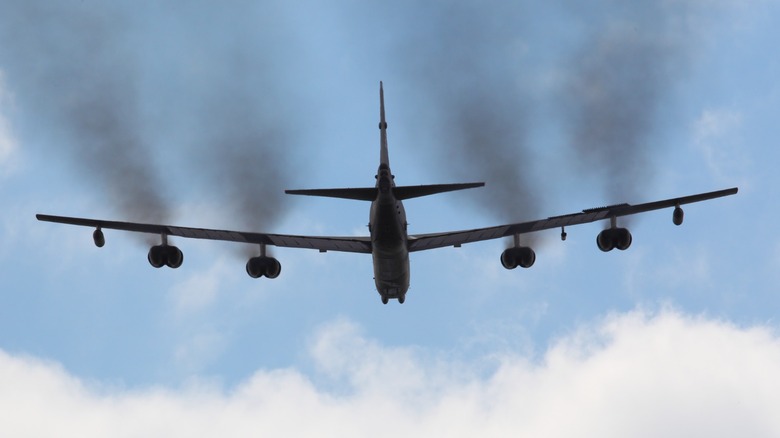Why Explosives Are Used To Start A B-52's Engines In An Emergency
Originally tested in 1953 and entering service in 1955, the iconic B-52 Stratofortress is one of the oldest aircraft still in service today. Despite its age, this eight-engine bomber remains an essential part of the United States' strategic bomber fleet and is expected to stay in service until 2050. Although the B-52s were upgraded to the newer H model in 1961, the bomber doesn't have some of the features we see on modern jets today.
One such module found on newer aircraft but missing from the B-52 is the APU, or auxiliary power unit. This means that the Stratofortress needs a pair of generators and air carts to jump-start two of its engines. These units provide external power and air to the aircraft until the pilots get enough bleed air to start them.
However, this startup procedure often takes more than an hour. In the case that a crew needs to get the bombers up in the air in an emergency, they can use small explosive cartridges to get the engines spinning in a hurry. This method, called cart start, cuts down the time a B-52 can get rolling from a cold start to about 10 minutes, allowing it and its crews to respond to threats in a much shorter time.
How does a 'cart start' work?
The explosive cartridges used in cart start, which look like giant shotgun shells, are around 10 inches wide and weigh around 8 pounds. Ground crews typically load these onto two engines, which are then electronically fired using the B-52's battery. This allows the plane to generate its own power through its engines and get into the air much faster. If the Air Force needed to scramble its jets and react to a threat in a hurry, a crew could theoretically cart start all eight of its engines to save extra time. This method of turning on the B-52 is quite exciting, but since it involves explosives, training for it ironically takes much longer than the standard startup procedure itself.
The cart start is going to be discontinued in a few years as the U.S. Air Force is taking steps to upgrade its B-52 fleet to modern standards with the J variant. Aside from replacing the old Pratt & Whitney TF33 engines with newer Rolls-Royce F130s, Honeywell will install two Auxiliary Starter Air Units (ASAUs) on the wings of the bomber. These ASAUs are based on the company's successful 36-150 APU, which can be found on several other fixed-wing aircraft and helicopters in both military and civilian applications. They aren't expected to arrive until the mid-2030s, though, so we still have a few years to enjoy the spectacle of B-52 bombers making loud bangs and spewing a lot of smoke from their engines as crews cart start their planes.
